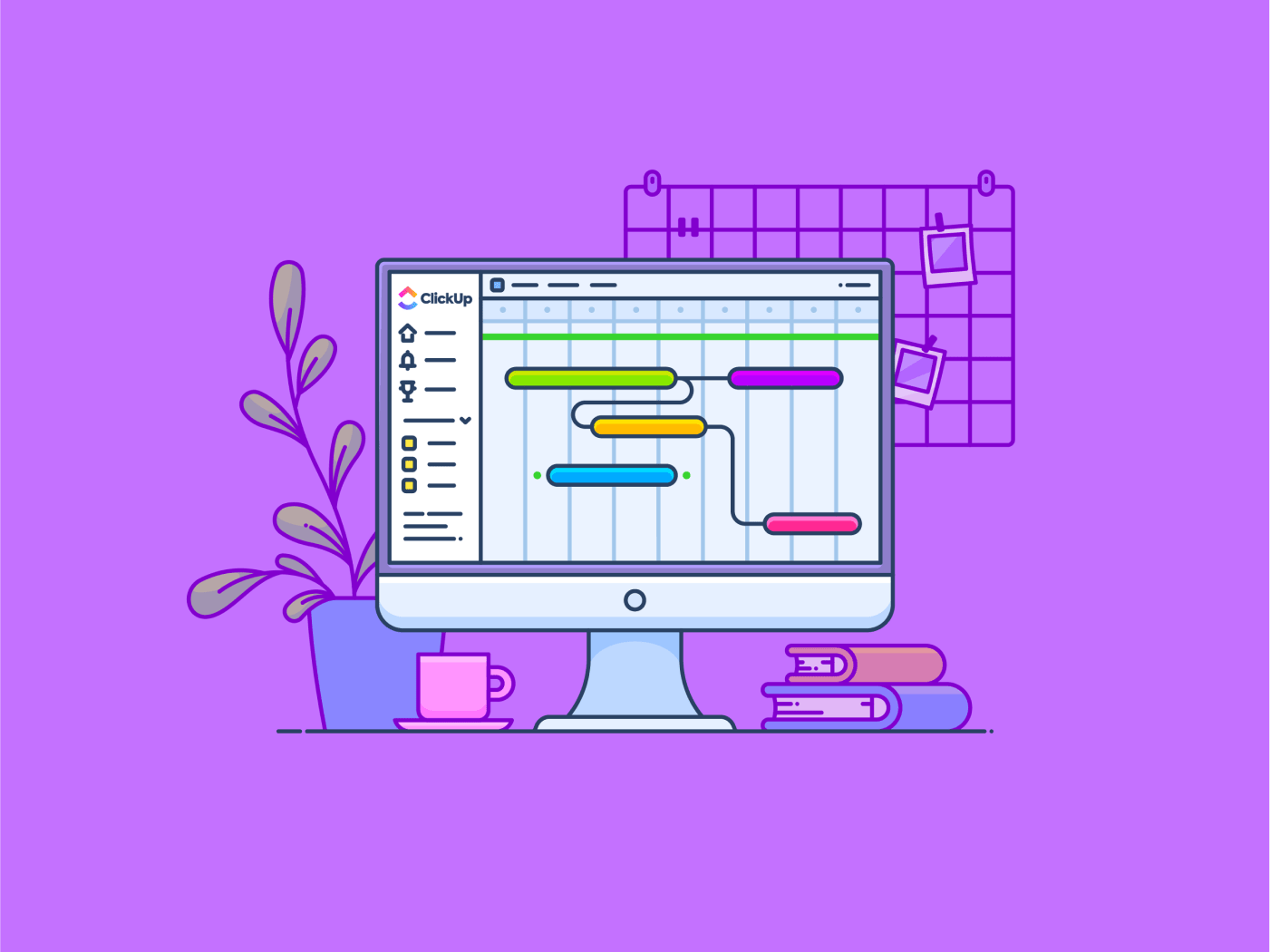How to Create a Gantt Chart in monday.com

Sorry, there were no results found for “”
Sorry, there were no results found for “”
Sorry, there were no results found for “”
You’ve got a project meeting in ten minutes, but your report is a tangled mess. Deadlines loom, and you can’t quite remember which tasks rely on others to be completed first.
All you need to get out of that mess is a Gantt chart! Gantt Charts are powerful visualization tools that clarify timelines, roadblocks, and project potential.
The popular work management platform monday.com simplifies and speeds up the process of creating Gantt charts. These bar charts depict project schedules, giving project managers a clear picture of task durations, dependencies, and the overall project timelines.
Let’s understand how.
You don’t need to build a Gantt chart from scratch on monday.com. Instead, you can use its views to visualize your tasks in a Gantt format.
Here’s how to create a simple Gantt chart on monday.com:

The first step is to create a board specifically for your project. Click the ‘+’ button in the top right corner of the sidebar and choose ‘Gantt chart’ from the options. Give your board a descriptive name—something that reflects the project at hand—and click ‘Create Board.’
For monday.com to translate your project tasks into a Gantt chart, it needs specific information. Ensure your board has at least the following columns:
💡Pro Tip: To gain further insights into your project, enhance your Gantt chart by adding columns such as ‘Status,’ ‘Assignee,’ or ‘Priority. ‘
Navigate to the ‘Board View’ menu located at the top of your board. From the dropdown menu, select ‘Gantt.’
Once done, the monday.com board will display your tasks as a visually appealing Gantt chart. Each task name appears as a bar on the timeline, with its length representing the designated duration in the ‘Timeline’ column.
monday.com offers some customization options to optimize your Gantt chart:
This level of visual organization simplifies project monitoring and communication within your team. Team members can easily view their assigned tasks and their relative position in the overall project timeline.
💡Pro Tip: Drag and drop tasks along the timeline to adjust their scheduling. Use the ‘+’ button next to each taskbar to create subtasks, ideal for breaking down complex tasks into manageable steps.
While monday.com offers a user-friendly experience for building Gantt charts, it’s important to acknowledge a few limitations:
If the limitations of monday.com’s Gantt charts pose a challenge to your project management needs, consider exploring more comprehensive project management software like ClickUp.
ClickUp is a highly customizable productivity platform designed to enhance processes, optimize resources, and foster team collaboration. It uniquely integrates work across various applications into a single, dynamic interface, and weekly updates aim to improve user experience.
The platform’s user-friendly design and adaptability enable it to grow alongside businesses, making it suitable for various applications. ClickUp’s comprehensive approach to work management distinguishes it from competitors, featuring a robust suite of built-in tools, including:
ClickUp’s key features address many of monday.com’s limitations related to Gantt charts. Here’s how:

There are several ways to create robust Gantt charts with ClickUp. Let’s start with ClickUp’s Gantt Chart View:
ClickUp offers various tools to help you consolidate and organize all project-related information. For instance, you can use ClickUp Goals to articulate your objectives and set measurable targets for tracking progress. Additionally, organizing your goals into folders can enhance convenience and facilitate easier monitoring.

During this phase,

Create a new list or folder in ClickUp. This will serve as the container for your project tasks. Input all the tasks you identified in step 1. Then, assign due dates for each task to establish a preliminary timeline. You can also add other pertinent task details using ClickUp’s Custom Fields.


Navigate to your list or folder. Go to the project container where your tasks are located. Then, click the ‘+ View’ button and select ‘Gantt.’ You can rename the view, make it private, or pin it for easy access.
The Gantt chart will display your tasks as horizontal bars, with the length representing duration and position indicating start and end dates. Create Dependencies between tasks to show which tasks must be completed before others can start. To do so:

To delete the Dependency, simply click the connection between tasks and press Delete.
💡Pro Tip: When the Reschedule dependencies option is enabled in the Gantt view Layout options, dragging a task with Dependencies will automatically reschedule all subsequent tasks in the chain.
After that:

Click on a taskbar to view and edit task details, including assignees, priority, and custom fields. Once that’s done, you can:
Additional tips:
Another way to create Gantt Charts with ClickUp is by using the ClickUp Simple Gantt Template. It is designed to simplify the creation and management of Gantt charts, making project timelines and dependencies more manageable.
🎯Also Read: How to Create a Gantt Chart in Confluence
Here are some benefits you’ll get from using this Gantt chart template:
Quick tips:
To add a Gantt chart to an existing ClickUp project, follow these steps:
While monday.com offers a basic Gantt chart functionality, ClickUp emerges as a more powerful and versatile tool for creating Gantt charts for project management. With its extensive customization options, robust resource management, and advanced reporting capabilities, ClickUp allows you to create clear, informative, and actionable Gantt charts.
Using Gantt charts’ visual power and ClickUp’s comprehensive features, you’ll gain a competitive edge in managing your projects efficiently and effectively.
Ready to experience the difference? Try ClickUp today and use the full potential of your project management endeavors!
© 2025 ClickUp